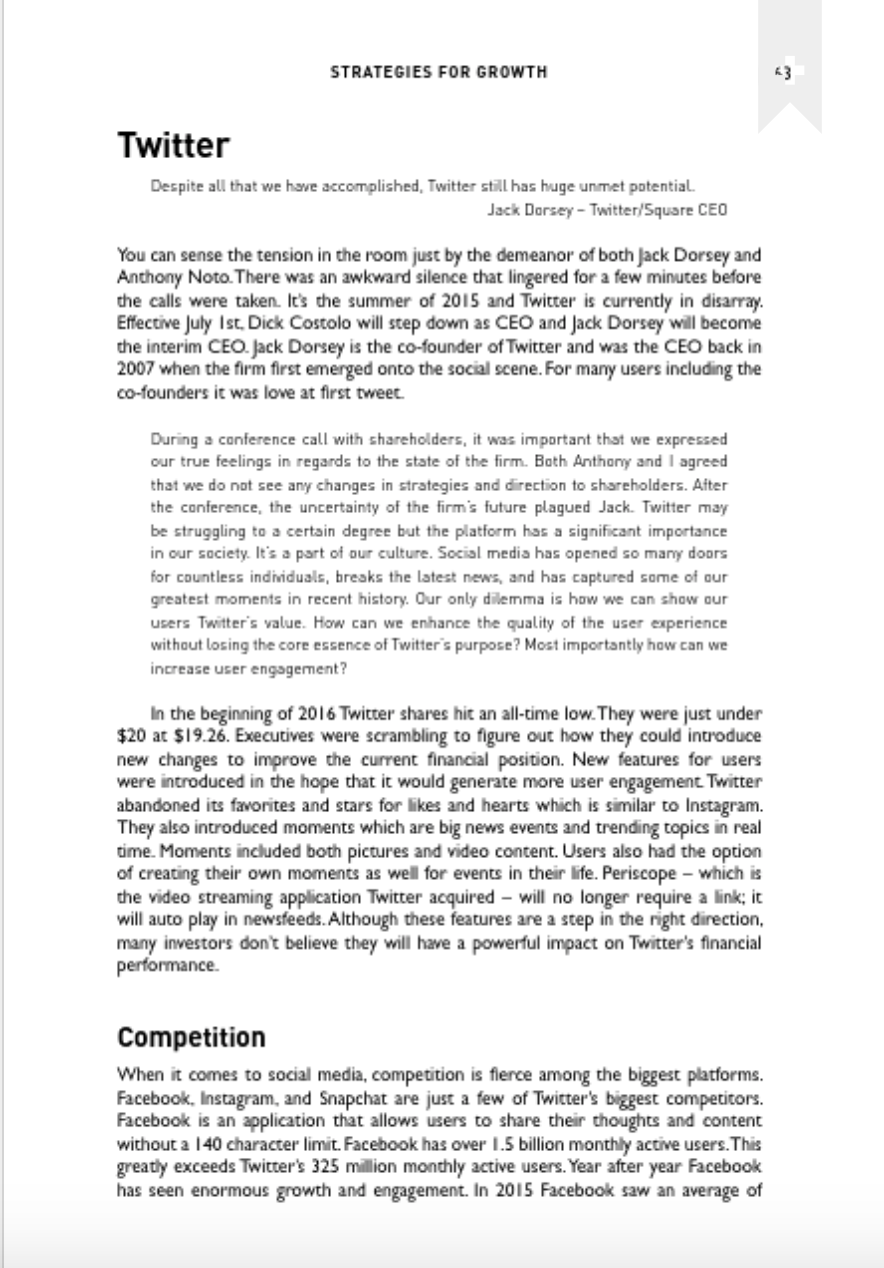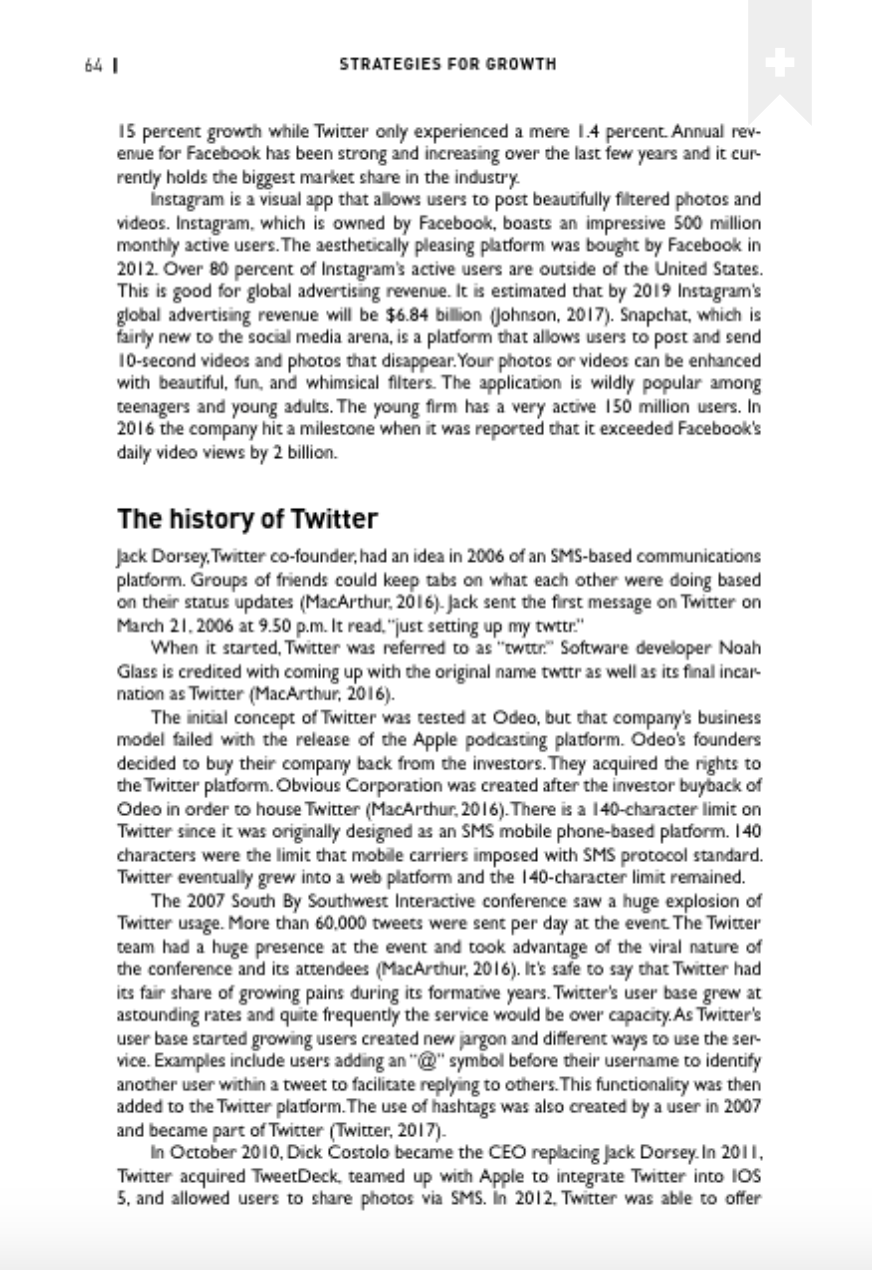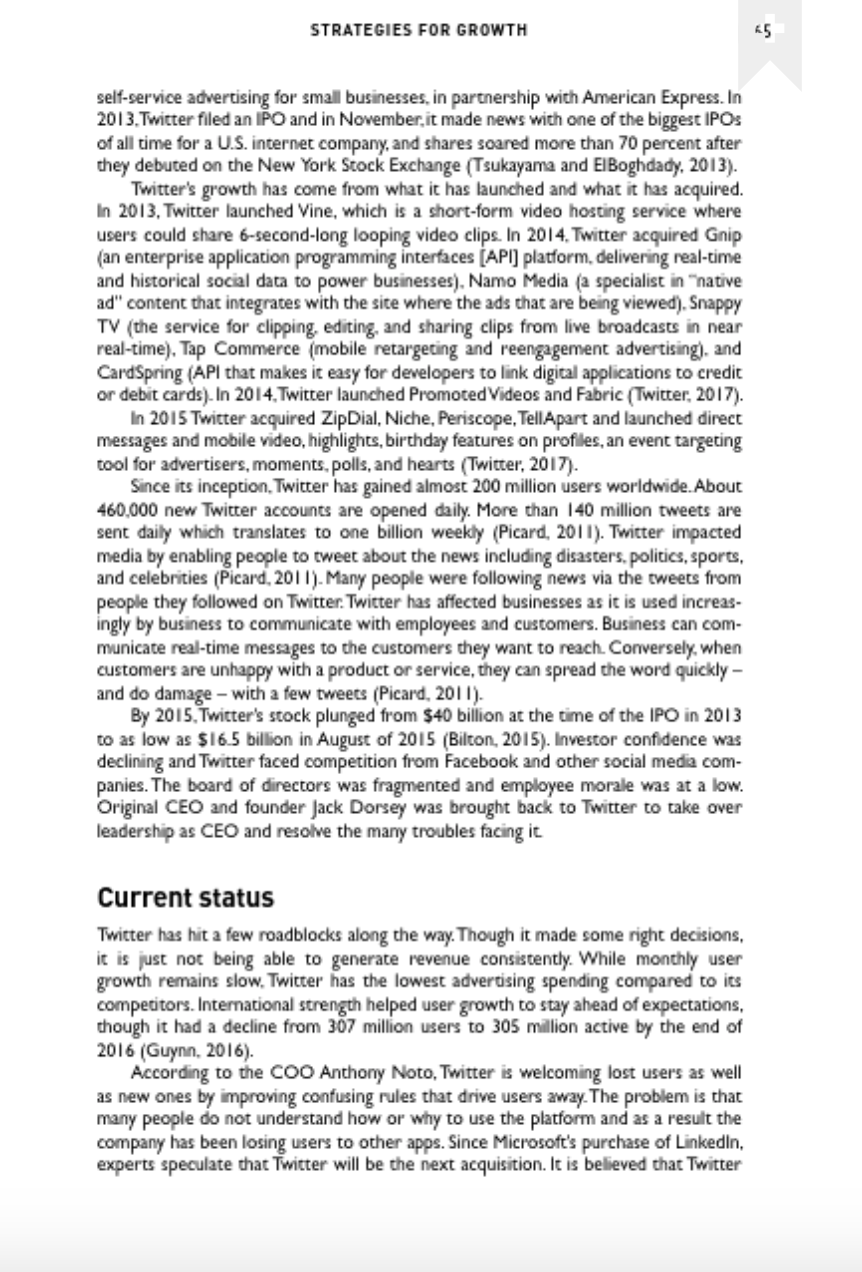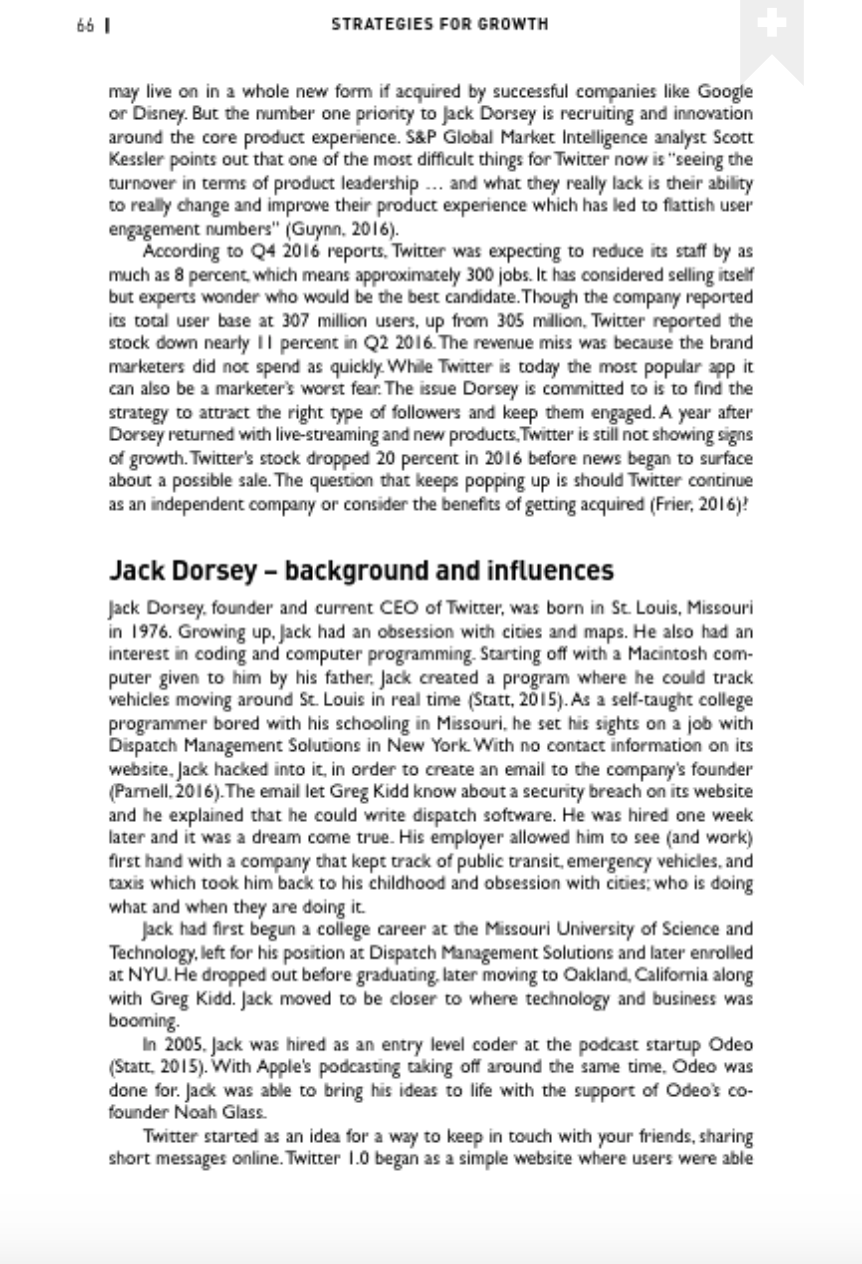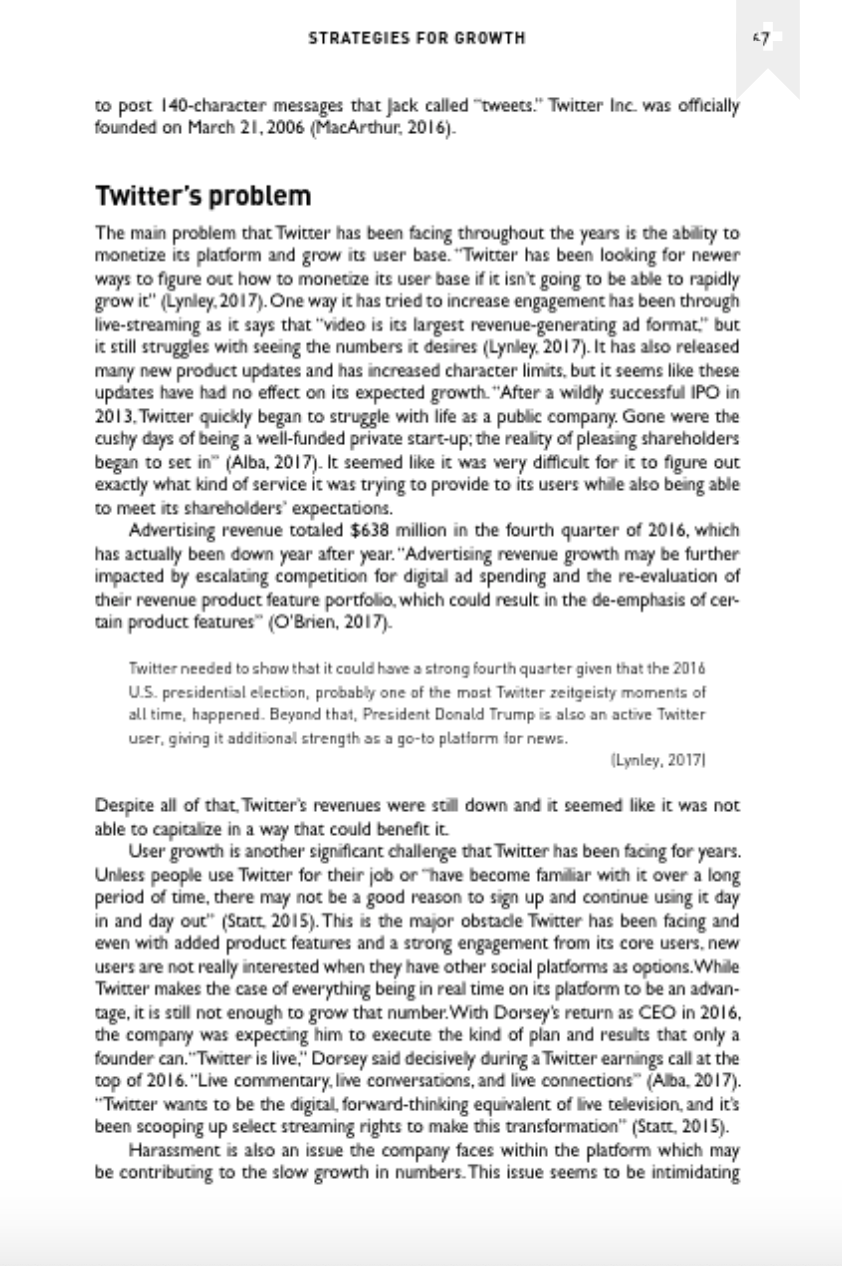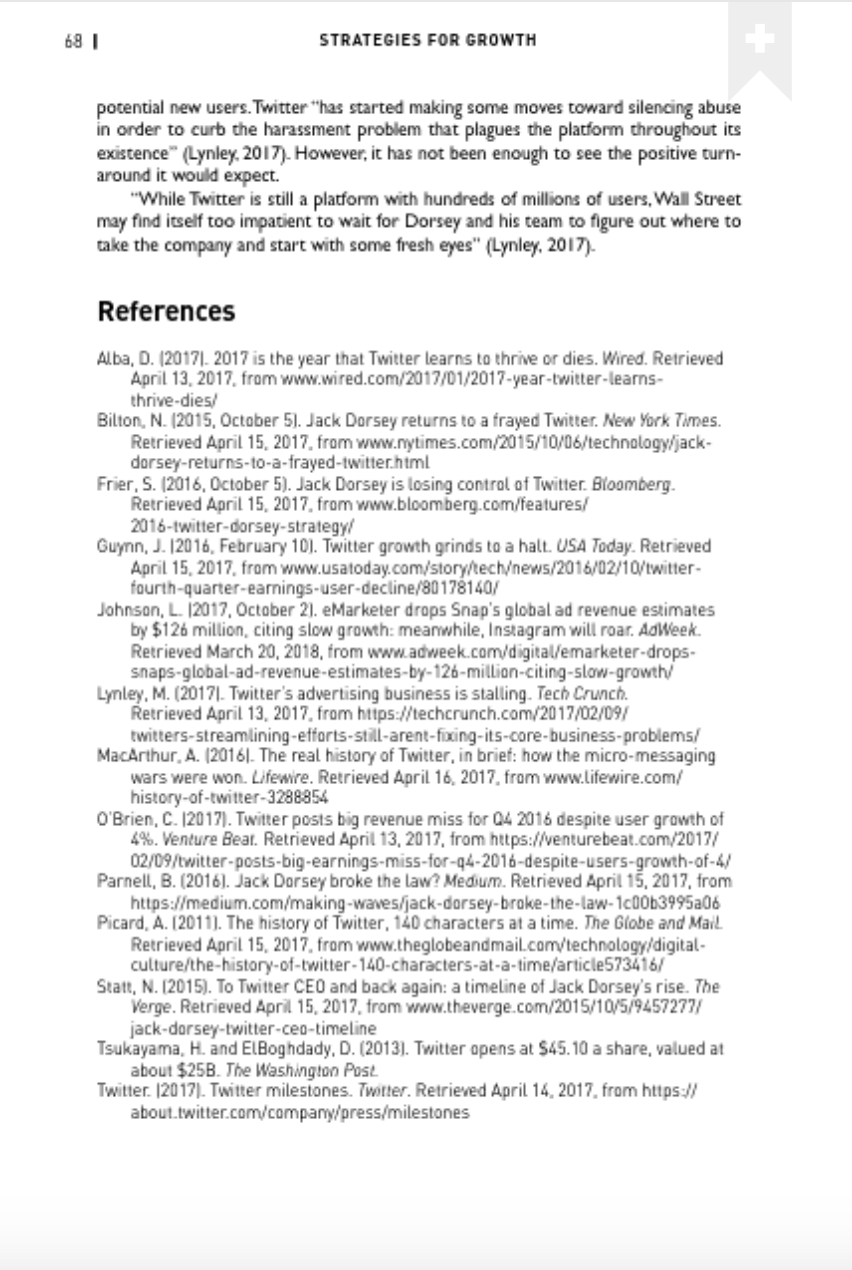STRATEGIES FOR GROWTH 43 Twitter Despite all that we have accomplished, Twitter still has huge unmet potential. Jack Dorsey - Twitter/Square CEO You can sense the tension in the room just by the demeanor of both Jack Dorsey and Anthony Noto. There was an awkward silence that lingered for a few minutes before the calls were taken. It's the summer of 2015 and Twitter is currently in disarray. Effective July Ist. Dick Costolo will step down as CEO and Jack Dorsey will become the interim CEO. Jack Dorsey is the co-founder of Twitter and was the CEO back in 2007 when the firm first emerged onto the social scene. For many users including the co-founders it was love at first tweet. During a conference call with shareholders, it was important that we expressed our true feelings in regards to the state of the firm. Both Anthony and I agreed that we do not see any changes in strategies and direction to shareholders. After the conference, the uncertainty of the firm's future plagued Jack. Twitter may be struggling to a certain degree but the platform has a significant importance in our society. It's a part of our culture. Social media has opened so many doors for countless individuals, breaks the latest news, and has captured some of our greatest moments in recent history. Our only dilemma is how we can show our users Twitter's value. How can we enhance the quality of the user experience without losing the core essence of Twitter's purpose? Most importantly how can we increase user engagement? In the beginning of 2016 Twitter shares hit an all-time low. They were just under $20 at $19.26. Executives were scrambling to figure out how they could introduce new changes to improve the current financial position. New features for users were introduced in the hope that it would generate more user engagement Twitter abandoned its favorites and stars for likes and hearts which is similar to Instagram. They also introduced moments which are big news events and trending topics in real time. Moments included both pictures and video content. Users also had the option of creating their own moments as well for events in their life. Periscope - which is the video streaming application Twitter acquired - will no longer require a link; it will auto play in newsfeeds. Although these features are a step in the right direction, many investors don't believe they will have a powerful impact on Twitter's financial performance. Competition When it comes to social media, competition is fierce among the biggest platforms. Facebook, Instagram, and Snapchat are just a few of Twitter's biggest competitors. Facebook is an application that allows users to share their thoughts and content without a 1 40 character limit. Facebook has over 1.5 billion monthly active users. This greatly exceeds Twitter's 325 million monthly active users. Year after year Facebook has seen enormous growth and engagement. In 2015 Facebook saw an average of64 1 STRATEGIES FOR GROWTH 15 percent growth while Twitter only experienced a mere 1.4 percent. Annual rev- enue for Facebook has been strong and increasing over the last few years and it cur- rently holds the biggest market share in the industry. Instagram is a visual app that alows users to post beautifully filtered photos and videos. Instagram, which is owned by Facebook, boasts an impressive 500 million monthly active users. The aesthetically pleasing platform was bought by Facebook in 2012. Over 80 percent of Instagram's active users are outside of the United States. This is good for global advertising revenue. It is estimated that by 2019 Instagram's global advertising revenue will be $6.84 billion (johnson, 2017). Snapchat, which is fairly new to the social media arena, is a platform that allows users to post and send 10-second videos and photos that disappear. Your photos or videos can be enhanced with beautiful, fun, and whimsical filters. The application is wildly popular among teenagers and young adults. The young firm has a very active 150 million users. In 2016 the company hit a milestone when it was reported that it exceeded Facebook's daily video views by 2 billion. The history of Twitter Jack Dorsey, Twitter co-founder, had an idea in 2006 of an SMS-based communications platform. Groups of friends could keep tabs on what each other were doing based on their status updates (MacArthur. 2016). Jack sent the first message on Twitter on March 21. 2006 at 9.50 p.m. It read, "just setting up my twttr." When it started, Twitter was referred to as "twttr." Software developer Noah Glass is credited with coming up with the original name twttr as well as its final incar- nation as Twitter (MacArthur, 2016). The initial concept of Twitter was tested at Odeo, but that company's business model failed with the release of the Apple podcasting platform. Odeo's founders decided to buy their company back from the investors. They acquired the rights to the Twitter platform. Obvious Corporation was created after the investor buyback of Odeo in order to house Twitter (MacArthur, 2016). There is a 140-character limit on Twitter since it was originally designed as an SMS mobile phone-based platform. 140 characters were the limit that mobile carriers imposed with SMS protocol standard. Twitter eventually grew into a web platform and the 140-character limit remained. The 2007 South By Southwest Interactive conference saw a huge explosion of Twitter usage. More than 60,000 tweets were sent per day at the event. The Twitter team had a huge presence at the event and took advantage of the viral nature of the conference and its attendees (MacArthur, 2016). It's safe to say that Twitter had its fair share of growing pains during its formative years. Twitter's user base grew at astounding rates and quite frequently the service would be over capacity. As Twitter's user base started growing users created new jargon and different ways to use the ser- vice. Examples include users adding an "@" symbol before their username to identify another user within a tweet to facilitate replying to others. This functionality was then added to the Twitter platform. The use of hashtags was also created by a user in 2007 and became part of Twitter (Twitter, 2017)- In October 2010, Dick Costolo became the CEO replacing Jack Dorsey. In 201 1, Twitter acquired TweetDeck, teamed up with Apple to integrate Twitter into IOS 5, and allowed users to share photos via SMS. In 2012. Twitter was able to offerSTRATEGIES FOR GROWTH self-service advertising for small businesses, in partnership with American Express. In 2013. Twitter filed an IPO and in November, it made news with one of the biggest IPOs of all time for a U.S. internet company, and shares soared more than 70 percent after they debuted on the New York Stock Exchange (Tsukayama and ElBoghdady, 2013). Twitter's growth has come from what it has launched and what it has acquired. In 2013, Twitter launched Vine, which is a short-form video hosting service where users could share 6-second-long looping video clips. In 2014. Twitter acquired Grip (an enterprise application programming interfaces [API] platform, delivering real-time and historical social data to power businesses). Namo Media (a specialist in "native ad" content that integrates with the site where the ads that are being viewed). Snappy TV (the service for clipping. editing. and sharing clips from live broadcasts in near real-time), Tap Commerce (mobile retargeting and reengagement advertising). and CardSpring (API that makes it easy for developers to link digital applications to credit or debit cards). In 2014. Twitter launched Promoted Videos and Fabric (Twitter, 2017). In 2015 Twitter acquired ZipDial, Niche, Periscope, TellApart and launched direct messages and mobile video, highlights, birthday features on profiles, an event targeting tool for advertisers, moments, polls, and hearts (Twitter, 2017). Since its inception. Twitter has gained almost 200 million users worldwide. About 460.000 new Twitter accounts are opened daily. More than 140 million tweets are sent daily which translates to one billion weekly (Picard, 201 1). Twitter impacted media by enabling people to tweet about the news including disasters, politics, sports, and celebrities (Picard, 201 1). Many people were following news via the tweets from people they followed on Twitter. Twitter has affected businesses as it is used increase ingly by business to communicate with employees and customers. Business can com- municate real-time messages to the customers they want to reach. Conversely, when customers are unhappy with a product or service, they can spread the word quickly - and do damage - with a few tweets (Picard, 201 1). By 2015. Twitter's stock plunged from $40 billion at the time of the IPO in 2013 to as low as $16.5 billion in August of 2015 (Bilton, 2015). Investor confidence was declining and Twitter faced competition from Facebook and other social media com- panies. The board of directors was fragmented and employee morale was at a low. Original CEO and founder Jack Dorsey was brought back to Twitter to take over leadership as CEO and resolve the many troubles facing it Current status Twitter has hit a few roadblocks along the way. Though it made some right decisions, it is just not being able to generate revenue consistently. While monthly user growth remains slow. Twitter has the lowest advertising spending compared to its competitors. International strength helped user growth to stay ahead of expectations, though it had a decline from 307 million users to 305 million active by the end of 2016 (Guynn, 2016). According to the COO Anthony Noto, Twitter is welcoming lost users as well as new ones by improving confusing rules that drive users away. The problem is that many people do not understand how or why to use the platform and as a result the company has been losing users to other apps. Since Microsoft's purchase of Linkedin, experts speculate that Twitter will be the next acquisition. It is believed that Twitter66 1 STRATEGIES FOR GROWTH may live on in a whole new form if acquired by successful companies like Google or Disney. But the number one priority to Jack Dorsey is recruiting and innovation around the core product experience. S&P Global Market Intelligence analyst Scott Kessler points out that one of the most difficult things for Twitter now is "seeing the turnover in terms of product leadership ... and what they really lack is their ability to really change and improve their product experience which has led to flattish user engagement numbers" (Guynn. 2016). According to Q4 2016 reports, Twitter was expecting to reduce its staff by as much as 8 percent, which means approximately 300 jobs. It has considered selling itself but experts wonder who would be the best candidate. Though the company reported its total user base at 307 million users, up from 305 million, Twitter reported the stock down nearly 1 1 percent in Q2 2016. The revenue miss was because the brand marketers did not spend as quickly While Twitter is today the most popular app it can also be a marketer's worst fear. The issue Dorsey is committed to is to find the strategy to attract the right type of followers and keep them engaged. A year after Dorsey returned with live-streaming and new products, Twitter is still not showing signs of growth. Twitter's stock dropped 20 percent in 2016 before news began to surface about a possible sale. The question that keeps popping up is should Twitter continue as an independent company or consider the benefits of getting acquired (Frier, 2016)! Jack Dorsey - background and influences Jack Dorsey, founder and current CEO of Twitter, was born in St. Louis, Missouri in 1976. Growing up, Jack had an obsession with cities and maps. He also had an interest in coding and computer programming. Starting off with a Macintosh com- puter given to him by his father, Jack created a program where he could track vehicles moving around St. Louis in real time (Statt, 2015). As a self-taught college programmer bored with his schooling in Missouri, he set his sights on a job with Dispatch Management Solutions in New York With no contact information on its website, Jack hacked into it, in order to create an email to the company's founder (Parnell. 2016). The email let Greg Kidd know about a security breach on its website and he explained that he could write dispatch software. He was hired one week later and it was a dream come true. His employer allowed him to see (and work) first hand with a company that kept track of public transit, emergency vehicles, and taxis which took him back to his childhood and obsession with cities; who is doing what and when they are doing it. Jack had first begun a college career at the Missouri University of Science and Technology, left for his position at Dispatch Management Solutions and later enrolled at NYU. He dropped out before graduating. later moving to Oakland, California along with Greg Kidd. Jack moved to be closer to where technology and business was booming. In 2005. Jack was hired as an entry level coder at the podcast startup Odeo (Statt. 2015). With Apple's podcasting taking off around the same time, Odeo was done for. Jack was able to bring his ideas to life with the support of Odeo's co- founder Noah Glass. Twitter started as an idea for a way to keep in touch with your friends, sharing short messages online. Twitter 1.0 began as a simple website where users were ableSTRATEGIES FOR GROWTH to post 140-character messages that Jack called "tweets." Twitter Inc. was officially founded on March 21, 2006 (MacArthur, 2016)- Twitter's problem The main problem that Twitter has been facing throughout the years is the ability to monetize its platform and grow its user base. "Twitter has been looking for newer ways to figure out how to monetize its user base if it isn't going to be able to rapidly grow it" (Lynley. 2017). One way it has tried to increase engagement has been through live-streaming as it says that "video is its largest revenue-generating ad format." but it still struggles with seeing the numbers it desires (Lynley. 2017). It has also released many new product updates and has increased character limits, but it seems like these updates have had no effect on its expected growth. "After a wildly successful IPO in 2013. Twitter quickly began to struggle with life as a public company. Gone were the cushy days of being a well-funded private start-up; the reality of pleasing shareholders began to set in" (Alba, 2017). It seemed like it was very difficult for it to figure out exactly what kind of service it was trying to provide to its users while also being able to meet its shareholders' expectations. Advertising revenue totaled $638 million in the fourth quarter of 2016, which has actually been down year after year. "Advertising revenue growth may be further impacted by escalating competition for digital ad spending and the re-evaluation of their revenue product feature portfolio, which could result in the de-emphasis of cer tain product features" (O'Brien, 2017). Twitter needed to show that it could have a strong fourth quarter given that the 2016 U.S. presidential election, probably one of the most Twitter zeitgeisty moments of all time, happened. Beyond that, President Donald Trump is also an active Twitter user, giving it additional strength as a go-to platform for news. (Lynley, 2017) Despite all of that, Twitter's revenues were still down and it seemed like it was not able to capitalize in a way that could benefit it. User growth is another significant challenge that Twitter has been facing for years. Unless people use Twitter for their job or "have become familiar with it over a long period of time, there may not be a good reason to sign up and continue using it day in and day out" (Statt. 2015). This is the major obstacle Twitter has been facing and even with added product features and a strong engagement from its core users, new users are not really interested when they have other social platforms as options. While Twitter makes the case of everything being in real time on its platform to be an advan- tage, it is still not enough to grow that number. With Dorsey's return as CEO in 2016, the company was expecting him to execute the kind of plan and results that only a founder can."Twitter is live," Dorsey said decisively during a Twitter earnings call at the top of 2016. "Live commentary, live conversations, and live connections" (Alba, 2017). "Twitter wants to be the digital, forward-thinking equivalent of live television, and it's been scooping up select streaming rights to make this transformation" (Statt, 2015). Harassment is also an issue the company faces within the platform which may be contributing to the slow growth in numbers. This issue seems to be intimidating68 1 STRATEGIES FOR GROWTH potential new users. Twitter "has started making some moves toward silencing abuse in order to curb the harassment problem that plagues the platform throughout its existence" (Lynley. 2017). However, it has not been enough to see the positive turn- around it would expect. "While Twitter is still a platform with hundreds of millions of users, Wall Street may find itself too impatient to wait for Dorsey and his team to figure out where to take the company and start with some fresh eyes" (Lynley, 2017). References Alba, D. (20171. 2017 is the year that Twitter learns to thrive or dies. Wired. Retrieved April 13, 2017. from www.wired.com/2017/01/2017-year-twitter-learns- thrive-dies/ Bilton, N. (2015, October 5]. Jack Dorsey returns to a frayed Twitter. New York Times. Retrieved April 15, 2017. from www.nytimes.com/2015/10/06/technology/jack- dorsey-returns-to-a-frayed-twitter.html Frier, S. (2016, October 5). Jack Dorsey is losing control of Twitter. Bloomberg. Retrieved April 15, 2017. from www.bloomberg.com/features/ 2016-twitter-dorsey-strategy/ Guynn, J. [2016. February 10]. Twitter growth grinds to a halt. USA Today. Retrieved April 15, 2017, from www.usatoday.com/story/techews/2016/02/10/twitter- fourth-quarter-earnings-user-decline/80178140/ Johnson, L. 12017, October 2]. eMarketer drops Snap's global ad revenue estimates by $126 million, citing slow growth: meanwhile, Instagram will roar. AdWeek. Retrieved March 20, 2018, from www.adweek.com/digital/emarketer-drops- snaps-global-ad-revenue-estimates-by-126-million-citing-slow-growth/ Lynley, M. (20171. Twitter's advertising business is stalling. Tech Crunch. Retrieved April 13, 2017. from https://techcrunch.com/2017/02/09/ twitters-streamlining-efforts-still-arent-fixing-its-core-business-problems/ MacArthur. A. (20161. The real history of Twitter, in brief: how the micro-messaging wars were won. Lifewire. Retrieved April 16. 2017. from www.lifewire.com/ history-of-twitter-3288854 O'Brien, C. (2017). Twitter posts big revenue miss for Q4 2016 despite user growth of 4%. Venture Bear. Retrieved April 13, 2017, from https://venturebeat.com/2017/ 02/09/twitter-posts-big-earnings-miss-for-q4-2016-despite-users-growth-of-4/ Parnell, B. (2016]. Jack Dorsey broke the law? Medium. Retrieved April 15, 2017, from https://medium.com/making-waves/jack-dorsey-broke-the-law- 1c00b3995a06 Picard, A. [2011]. The history of Twitter, 140 characters at a time. The Globe and Mail Retrieved April 15, 2017. from www.theglobeandmail.com/technology/digital- culture/the-history-of-twitter - 140-characters-at-a-time/article573416/ Statt, N. [2015). To Twitter CEO and back again: a timeline of Jack Dorsey's rise. The Verge. Retrieved April 15, 2017, from www.theverge.com/2015/10/5/9457277/ jack-dorsey-twitter-ceo-timeline Tsukayama, H. and ElBoghdady, D. (2013]. Twitter opens at $45. 10 a share, valued at about $25B. The Washington Post Twitter. [2017). Twitter milestones. Twitter. Retrieved April 14. 2017. from https:// about.twitter.com/company/press/milestones
